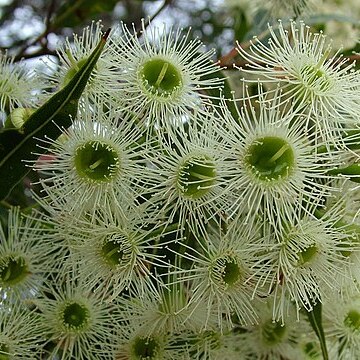Tree to 35 m tall, rarely a mallee. Forming a lignotuber.Bark usually rough to small branches, tessellated, predominantly grey or brown, with reddish or pinkish, yellow or orange patches; smooth bark of mallees pale orange, pink, white or grey.Juvenile stem rounded in cross-section, scabrid; juvenile leaves always petiolate, peltate for the first 8 to 10 nodes, opposite for 4 to 10 nodes then alternate (but may revert for a few nodes), ovate to elliptical to lanceolate, 9–16.5 cm long, 3–5.2 cm wide, base of lamina rounded at first then tapering, discolorous, green; stems and leaves setose for up to ca 10 nodes.Adult leaves alternate, petiole 0.8–2.3 cm long; blade lanceolate, 5.5–16 cm long, 1.5–5 cm wide, flat or undulate, base tapering to petiole, discolorous, glossy or dull, green, strongly penniveined, densely to very densely reticulate, intramarginal vein parallel to and just within margin, oil glands obscure or island.Inflorescence terminal compound, peduncles 1.7–3.3 cm long, buds 7 per umbel, pedicels 0.2–1.5 cm long. Mature buds obovoid to pyriform, 0.8–1.2 cm long, 0.4–0.6 cm wide, green or creamy, smooth, scar absent (both opercula shed together at flowering), operculum slightly beaked to conical to rounded, stamens inflexed, anthers cuboid to oblong, versatile, dorsifixed, dehiscing by longitudinal slits (non-confluent), style long, locules 3 or 4, the placentae each with 4 vertical ovule rows. Flowers creamy white.Fruit pedicellate (pedicels 0.2–1.6 cm long), urceolate, 1.2–2.2 cm long, 0.9–1.8 cm wide, disc descending, valves 3 or 4, deeply enclosed.Seeds brown or reddish brown, 5–8 mm long, more or less elongated boat-shaped, dorsal surface smooth but more or less keeled, not terminally winged but with narrow marginal flange around part of seed, hilum ventral. Cultivated seedlings (measured at ca node 10): cotyledons reniform to orbicular; stems rounded in cross-section, scabrid on lower part; leaves always petiolate, opposite for 4 to 7 nodes, elliptical to ovate with base rounded to puckered with petiole peltately inserted on the underside of the lamina, then becoming alternate, ovate to lanceolate, 6–13 cm long, 2–5.3 cm wide, base no longer peltate after ca node 8–10, discolorous, glossy, darker green above. Leaves scabrid on underside until ca node 8.
More
Tree to 35 m. Bark tessellated throughout, grey-brown or brown. Juvenile leaves alternate, petiolate, ovate to broadly lanceolate, discolorous, setose. Adult leaves alternate, lanceolate or broadly lanceolate, acuminate, thick; lamina 10–14 cm long, 2–4 cm wide, shining, dark green above, discolorous; lateral veins numerous, faint, at 60°–70°; intramarginal vein c. 1 mm from margin; petiole flattened, 10–23 mm long. Umbels 7-flowered; peduncle flattened or angular, sometimes terete, 17–30 mm long; pedicels 9–14 mm long. Buds obovoid to clavate; operculum hemispherical-conical, apiculate, 2–4 mm long, 6–7 mm wide; hypanthium pyriform, 7–9 mm long, 5–8 mm wide. Fruits urceolate, 15–20 mm long, 11–15 mm wide. Seeds without or with rudimentary marginal wing, red-brown.
A medium to tall tree. It grows 10-25 m high. It spreads 8-15 m wide. The branches are often crooked. The bark is brown and cracked into squares. The leaves are light green. The flowers are cream.


